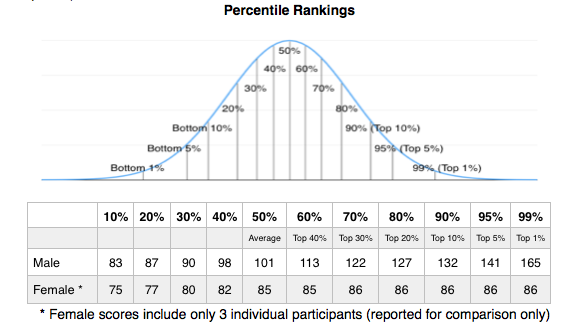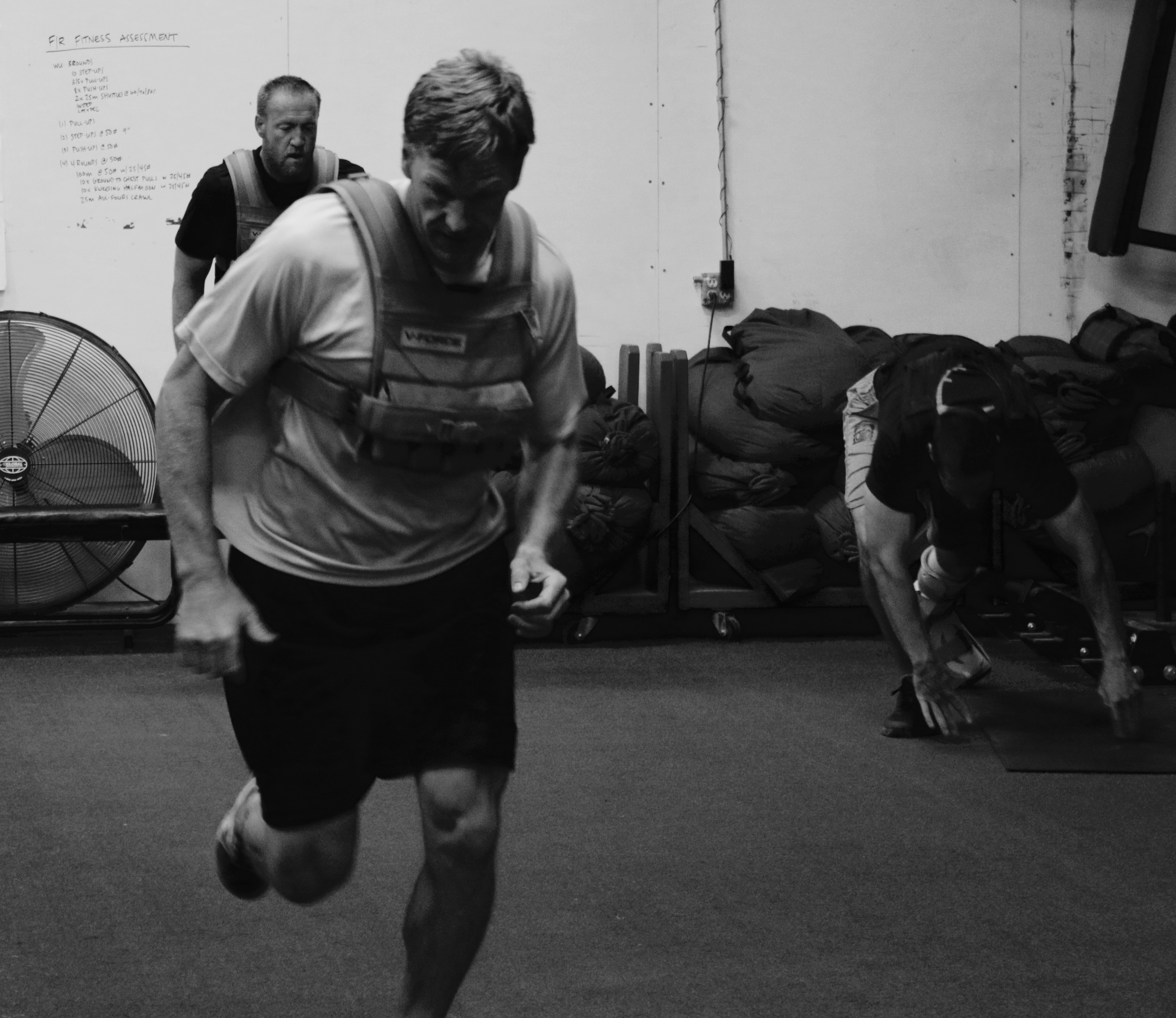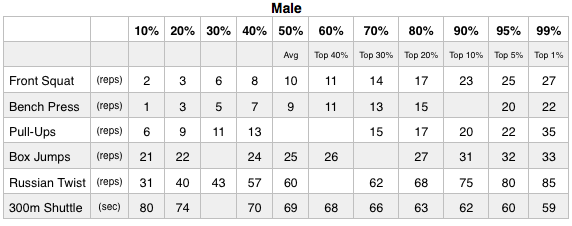In 2014, we published our basic fitness assessment for Law Enforcement Athletes. Since then hundreds of athletes have completed the assessment. Some athletes have done so during our daily sessions, while others were part of cadet classes that have adopted the assessment.
When we started our second training cycle, designed specifically around the test, we asked LE Athletes to submit their scores so that we could begin building a database of results. We have received just under 100 scores. These scores represent a snapshot of our LE Athletes. Below is a brief break-down of the results so far.
Test Basics
The LE Athlete Fitness Assessment is designed to assess muscular endurance, strength, and anaerobic capacity. There are six total events:
(1) Max Reps Front Squats in 60 Seconds (Men at bodyweight, Women at 75% BW)
(2) Max Reps Bench Press in 60 Seconds (Men at bodyweight, Women at 75% BW)
(3) Max Reps Bodyweight Strict Pull Ups (men), Chin ups (women)
(4) Box Jumps in 60 Seconds for Reps @ 20/24” box (20” for women)
(5) Max Reps Seated Russian Twist in 60 Seconds for Reps @ 35/45# Dumbbell
(6) 300m Shuttle wearing IBA, Weapon and Duty Belt, for Time
Athletes earn points during each event (and must score at least 1 point in each event to pass). For the first five events points are earned based on the number of repetitions completed. For the 300m shuttle, points are calculated based on the athlete’s time (70 seconds = 20 points, 90 seconds = 0 points). Points from all six events are added together to create an overall test score.
For Example:
 Note: If you want more information on the scoring system, a complete explanation is available at the LE Athlete Fitness Assessment link.
Note: If you want more information on the scoring system, a complete explanation is available at the LE Athlete Fitness Assessment link.
Subjects
The results below represent data from 92 male LE Athletes. These athletes were mostly young (average age was 31.2 years), of average height (71 inches), and had a BMI of 27.2 (average).
Unfortunately, we only received responses from 3 female athletes. While we have provided basic demographics for the trio below, based on the small sample size, these scores are not necessarily a great representation of the general female LE Athlete population.
Total Score
Total scores were broken down by males and females. For males the average score was 106.9. The highest male score recorded was a 175 and the lowest was a 70. For females the average score was 81.0. The highest female score was 86 and the lowest was 72.
Below is a table which displays score ranges based on percentile rankings. The percentile scores provide a basic framework for comparing your scores to the other participants. For example, if you are a male who scored a 123 points, then you fall into the 70th percentile (122-126). This means you scored higher than 70% of all other male participants (i.e. you are in the top 30%). 
Individual Events
We also developed percentile scores for each event. In the table below you can find the corresponding scores for each event – from the bottom 10% to top 1%.
Note: We did not include female scores in this portion of the article because the small number of scores produced very unreliable results.
Discussion
Overall, the scores we received were higher than expected. Athlete age likely played a major role in the higher scores. As did the fact that, by their nature, the scores came from a sub-section of LE professionals who are likely dedicated to professional fitness. Simply point, anyone who took the test was either involved in a cadet academy training program or was training with the LE Athlete daily sessions.
Based on this, it is probably safe to say that these percentiles represent a sub-section of the fitter LE professionals. Basically, if an athlete’s scores place them in the top 30% then they are likely in the top 30% of the fittest LE professionals – not the general LE population.
Problems
Unfortunately, the high scores also led to a little skepticism in the results. Two specific event scores jump-out as possibly problematic. The first is pull-ups and the second is the 300m Shuttle.
The overall pull-up average for males was 14.0 repetitions. This score seems extremely high based on our experience working with LE Athletes. Just to make the bottom 10% an athlete needed to complete 6 body weight pull-ups. While we have very little specific data to back-up this skepticism, based on our anecdotal experience these scores just seem high.
The 300m shuttle was also an event where results seemed highly skewed. During the LE Athlete Assessment the 300m Shuttle is completed wearing a duty belt and weapon (or in some cases 20# vest to simulate). The scores we received ranged from 53 to 93 seconds. This is a huge range for such a short event. Also, the fastest scores are far outside the times we have experienced first-hand while administering the test.
For example, when we compare our LE Athlete 300m Shuttle times to a 300yd Shuttle report from the College of William and Mary we find a troubling contrast. Below is a table which contains the comparison. Based on reported times, LE Athlete are running their shuttles at similar speeds to NCAA Division I football players (and LE Athletes are running a slightly longer distance (meters instead of years) and are under additional load).
 Source: http://web.wm.edu/speedstrength/Exercise%20Technique/300%20shuttle.pdf
Source: http://web.wm.edu/speedstrength/Exercise%20Technique/300%20shuttle.pdf
I point to these two scores specifically, not to call-out any perceived dishonesty, but instead to draw attention to the importance of accuracy in testing standards. Whether we are talking about strict form during pull-ups or strict measurements in shuttle runs, for test results to have any reliability and validity it is vital that everyone conforms to the standards set forth in the instruction.
Moving Forward
For our data to have any meaning we have to ensure that it is true and accurate. This is one of the powers of the Cooper Institute Tests. Despite their controversy, since their inception in 1971 they have been strictly administered to over 110,000 patients. The shear volume of data the Institute has been able to amass over the past 44 years is what makes the tests so appealing to the LE community and has allowed them to stand-up to numerous court challenges over the years.
I will be the first to admit that our LE Athlete Fitness Assessment is far from perfect. However, we believe, it is a step in the right direction. As we continue to refine and improve our assessments we also need to ensure we are enforcing the standards on which they are built.
Moving forward, please continue to send us your scores so we can keep building our database – just keep the scoring strict. This will allow us to periodically update results and provide our athletes with better comparative data.
Questions? E-mail coach@mtntactical.com
Comments? Please feel free to leave a comment below.
MTI’s LE Fitness Assessment HERE



